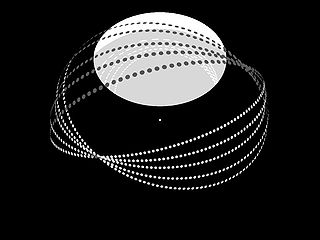
The Drake equation is a probabilistic argument used to estimate the number of active, communicative extraterrestrial civilizations in the Milky Way Galaxy.

The Fermi paradox is the discrepancy between the lack of conclusive evidence of advanced extraterrestrial life and the apparently high likelihood of its existence. As a 2015 article put it, "If life is so easy, someone from somewhere must have come calling by now."
The search for extraterrestrial intelligence (SETI) is a collective term for scientific searches for intelligent extraterrestrial life, for example, monitoring electromagnetic radiation for signs of transmissions from civilizations on other planets.

The Bussard ramjet is a theoretical method of spacecraft propulsion for interstellar travel. A fast moving spacecraft scoops up hydrogen from the interstellar medium using an enormous funnel-shaped magnetic field ; the hydrogen is compressed until thermonuclear fusion occurs, which provides thrust to counter the drag created by the funnel and energy to power the magnetic field. The Bussard ramjet can thus be seen as a ramjet variant of a fusion rocket.

The Kardashev scale is a method of measuring a civilization's level of technological advancement based on the amount of energy it is capable of using. The measure was proposed by Soviet astronomer Nikolai Kardashev (1932–2019) in 1964 and was named after him.
The fission sail is a type of spacecraft propulsion proposed by Robert Forward that uses fission fragments to propel a large solar sail-like craft. It is similar in concept to the fission-fragment rocket in that the fission by-products are directly harnessed as working mass, and differs primarily in the way that the fragments are used for thrust.

The communication with extraterrestrial intelligence (CETI) is a branch of the search for extraterrestrial intelligence (SETI) that focuses on composing and deciphering interstellar messages that theoretically could be understood by another technological civilization. The best-known CETI experiment of its kind was the 1974 Arecibo message composed by Frank Drake.

Stellar engines are a class of hypothetical megastructures which use the resources of a star to generate available work. For instance, they can use the energy of the star to produce mechanical, electrical or chemical work or they can use the impulse of the light emitted by the star to produce thrust, able to control the motion of a star system. The concept has been introduced by Bădescu and Cathcart. The variants which produce thrust may accelerate a star and anything orbiting it in a given direction. The creation of such a system would make its builders a type-II civilization on the Kardashev scale.
An interstellar war is a hypothetical space war between combatants from different planetary systems. The concept provides a common plot device in science fiction, especially in the space opera subgenre. In contrast, the term intergalactic war refers to war between combatants from different galaxies, and interplanetary war refers to war between combatants from different planets of the same planetary system.

A Bracewell probe is a hypothetical concept for an autonomous interstellar space probe dispatched for the express purpose of communication with one or more alien civilizations. It was proposed by Ronald N. Bracewell in a 1960 paper, as an alternative to interstellar radio communication between widely separated civilizations.

Abraham "Avi" Loeb is an Israeli-American theoretical physicist who works on astrophysics and cosmology. Loeb is the Frank B. Baird Jr. Professor of Science at Harvard University, where since 2007 he has been Director of the Institute for Theory and Computation at the Center for Astrophysics. He chaired the Department of Astronomy from 2011–2020, and founded the Black Hole Initiative in 2016.
Active SETI is the attempt to send messages to intelligent extraterrestrial life. Active SETI messages are predominantly sent in the form of radio signals. Physical messages like that of the Pioneer plaque may also be considered an active SETI message. Active SETI is also known as METI.

An interstellar object is an astronomical object in interstellar space that is not gravitationally bound to a star. This term can also be applied to an object that is on an interstellar trajectory but is temporarily passing close to a star, such as certain asteroids and comets. In the latter case, the object may be called an interstellar interloper.
The cultural impact of extraterrestrial contact is the corpus of changes to terrestrial science, technology, religion, politics, and ecosystems resulting from contact with an extraterrestrial civilization. This concept is closely related to the search for extraterrestrial intelligence (SETI), which attempts to locate intelligent life as opposed to analyzing the implications of contact with that life.

Technosignature or technomarker is any measurable property or effect that provides scientific evidence of past or present technology. Technosignatures are analogous to biosignatures, which signal the presence of life, whether intelligent or not. Some authors prefer to exclude radio transmissions from the definition, but such restrictive usage is not widespread. Jill Tarter has proposed that the search for extraterrestrial intelligence (SETI) be renamed "the search for technosignatures". Various types of technosignatures, such as radiation leakage from megascale astroengineering installations such as Dyson spheres, the light from an extraterrestrial ecumenopolis, or Shkadov thrusters with the power to alter the orbits of stars around the Galactic Center, may be detectable with hypertelescopes. Some examples of technosignatures are described in Paul Davies's 2010 book The Eerie Silence, although the terms "technosignature" and "technomarker" do not appear in the book.

ʻOumuamua is the first interstellar object detected passing through the Solar System. Formally designated 1I/2017 U1, it was discovered by Robert Weryk using the Pan-STARRS telescope at Haleakalā Observatory, Hawaii, on 19 October 2017, approximately 40 days after it passed its closest point to the Sun on 9 September. When it was first observed, it was about 33 million km from Earth and already heading away from the Sun.
METI International, known simply as METI, is a non-profit research organization founded in July 2015 by Douglas Vakoch that creates and transmits interstellar messages to attempt to communicate with extraterrestrial civilizations. It is based in San Francisco, California.

Douglas A. Vakoch is an American astrobiologist, search for extraterrestrial intelligence (SETI) researcher, psychologist, and president of METI International, a nonprofit research and educational organization devoted to transmitting intentional signals to extraterrestrial civilizations. Vakoch led METI's participation in Sónar Calling GJ 273b, which transmitted a series of interstellar messages to Luyten's Star, located 12.4 light years from Earth. Vakoch advocates ongoing transmission projects, arguing that this does not increase risks of an alien invasion as suggested by British cosmologist Stephen Hawking. He has participated in several SETI observation programs, and after sixteen years at the SETI Institute, where he was director of Interstellar Message Composition, Vakoch founded METI International. He has edited over a dozen books in SETI, astrobiology, the psychology of space exploration, and ecocriticism. He is general editor of two-book series in ecocriticism and in the intersection of space and society. Vakoch has appeared widely on television and radio as a commentator on SETI and astrobiology. He is an emeritus professor of clinical psychology at the California Institute of Integral Studies (CIIS).

Alberto Caballero is a Spanish astronomer and science communicator. He is known for having identified a Sun-like star in the sky region where the Wow! signal came from as one of the possible sources of the radio signal. Caballero is also known for founding and coordinating the Habitable Exoplanet Hunting Project, an international effort consisting of more than 30 observatories searching for nearby potentially habitable exoplanets. Data is collected 24/7 from specific stars by observatories located both in the Northern and Southern hemispheres, and an initial list of exoplanet candidates was made public in 2020.
The Galileo Project is an international scientific research project to systematically search for extraterrestrial intelligence or extraterrestrial technology on and near Earth and to identify the nature of anomalous Unidentified Flying Objects/Unidentified Aerial Phenomena (UFOs/UAP).













